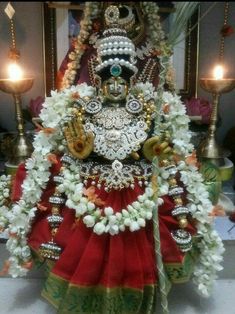The few coming namas talk about the physical body and the subtle body, that is, kshetra and Kshetrajna.
क्षेत्र-स्वरूपा (341)
Kṣetra-svarūpā
Kṣetra is gross physical body and kṣetrajña is the soul, subtle body. Kṣetra is perishable, whereas the knower of Kṣetra, kṣetrajña is eternal and imperishable.
She is said to be in the form of kṣetra and Shiva is said to be Kshetrajna.
क्षेत्रेशी (342)
Kṣtreśī
Wife of Kṣetrajña (Śiva) is Kṣtreśī (Śaktī). It is like Bhairava and Bhairavī
क्षेत्र-क्षेत्रज्ञ-पालिनी (343)
Kṣetra-kṣetrajña-pālinī
The protector of both kṣetra and Kṣetrajña. She protects both viz. the gross body and the soul.
क्षय-वृद्धि-विनिर्मुक्ता (344)
Kṣaya-vṛddhi-vinirmuktā
She is beyond growth and decay. These are associated with all mortals.
क्षेत्र-पाल-समर्चिता (345)
Kṣetra-pāla-samarcitā
Ksetra, the body is protected (Pala) by panchabhuta, five elements. Each of these five elements is represented by a demigod. She's worshiped by them also.
विजया (346)
Vijayā
She is always victorious.
विमला (347)
Vimalā
She is devoid of impurities.
वन्द्या (348)
Vandyā
She is adorable. We adore someone by merely seeing him and without even knowing him. This happens because he draws divine energy from the cosmos and this gets reflected through his body as vibrations. Such vibrations are normally drawn through an orifice in the crown cakra and also through medulla oblongata which is situated beneath the back of our head.
The third eye, the pineal gland and the back head cakra are placed in a straight line. When one is able to look within through the ājñā cakra, the energy generated passes through the pineal gland and gets released through the back head cakra and in the process cleanses bio-plasma body. This process not only accelerates one’s spiritual progress but also rarely confers some super human powers (siddhi-s).
वन्दारु-जन-वत्सला (349)
Vandāru-jana-vatsalā
She loves Her devotees like a mother who loves her children.
वाग्वादिनी (350)
Vāgvādinī
She prompts speech or She is in the form of speech itself. She is the origin of speech, She is Vāgvādinī.
वामकेशी (351)
Vāmakeśī
Wife of Vāmakeśvarā is Vāmakeśī. Śiva introduced twenty eight tantra-s (as per Śaivasiddhānta) to the universe and one among them is called Vāmakeśa tantra. This deals only with Her worship, hence She is called Vāmakeśī.
Vāma has innumerable meanings such as beautiful, splendid, Śiva, Durgā, Lakṣmī, Sarasvatī, a beautiful woman, wife, left side, etc. Keśa means hair. Then this nāma also means a beautiful woman (Goddess) with a beautiful hair.
वह्नि-मण्डल-वासिनी (352)
Vahni-maṇḍala-vāsinī
She lives in the sphere of fire. Vahni means fire. The sphere of fire is said to be in mūlādhāra cakra and in ākāś or ether.
भक्तिमत्-कल्प-लतिका (353)
Bhaktimat-kalpa-latikā
Kalpa is a divine creeper that grants boon to those who sit under it. Latika means spread over. She gives boon to Her devotees spread over the humanity, like the divine creeper, kalpa.
पशु-पाश-विमोचनी (354)
Paśu-pāśa-vimocanī
Paśu-s are the individual souls and pāśa is the bondage .
Ignorance is the cause for bondage that veils the true Brahman. She relieves her devotees from this bondage.
संहृताशेष-पाषण्डा (355)
Saṃhṛtāśeṣa-pāṣaṇḍā
She destroys all those who act against the principles of Veda-s.
सदाचार-प्रवर्तिका (356)
Sadācāra-pravartikā
She removes the innate ignorance of the soul to realize the Brahman. Sat refers those who perform noble deeds and ācāra means the righteous acts performed by them. She makes the ignorant people to pursue the righteous path to realize the Brahman.
तापत्रयाग्नि-सन्तप्त-समाह्लादन-चन्द्रिका (357)
Tāpatrayāgni-santapta-samāhlādana-candrikā
By Her sheer grace and moon like presence, she destroys the miseries caused by afflictions and showers happiness to Her devotees.
तरुणी (358)
Taruṇī
She is eternally youthful
तापसाराध्या (359)
Tāpasārādhyā
She is worshipped by ascetics.
There is yet another interpretation. Tāpa means bondage which is the root of all miseries. Sārādhyā is split into sāra (essence) + ā (deep) + dhyā (dhyān or meditation). The bondage arising out of saṁsāra can only be removed by meditating on Her.
तनुमध्या (360)
Tanumadhyā
She has slender waist.
There is a meter by name tanumadhya. Meter or chandas refers to the number of alphabets or words in a verse as per Sanskrit literature. She is said to be in the form of this meter. An example for such a reference can be found in Bhagavad Gīta X.35. Krishna says Gāyatrī chandasāmahaṁ (गायत्री चन्दसामहं) meaning that He is in the form Gāyatrī meter.
तमोsपहा (361)
Tamopahā
Tamas means ignorance and its main components are mental darkness, ignorance, illusion, error. Tamo guṇa is one of the three guṇa-s. An ignorant person is said to have tamo guṇa. She is said to remove this ignorance.
चितिः (362)
Citiḥ
She is in the form of eternal knowledge. Cit can be explained as pure knowledge that helps in realizing the Brahman.
तत्पद-लक्ष्यार्था (363)
Tatpada-lakṣhyārthā
Tat means that and pada means word. Tatpada (that word) means THAT referring the Brahman. She's the embodiment of THAT.
चिदेक-रस-रूपिणी (364)
Cideka-rasa-rūpiṇī
She is the essence of knowledge.
स्वात्मानन्द-लवी-भूत-ब्रह्माद्यानन्द-सन्ततिः (365)
Svātmānanda-lavī-bhūta-brahmādyānanda-santatiḥ
The sum total of bliss of Gods like Brahma and others is only a droplet of Her bliss.










No comments:
Post a Comment